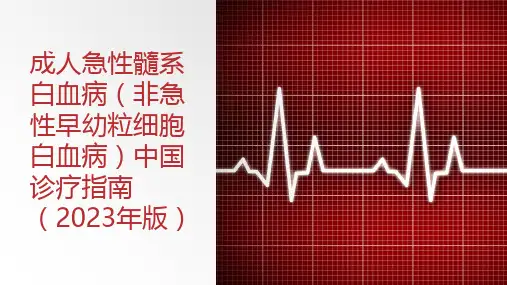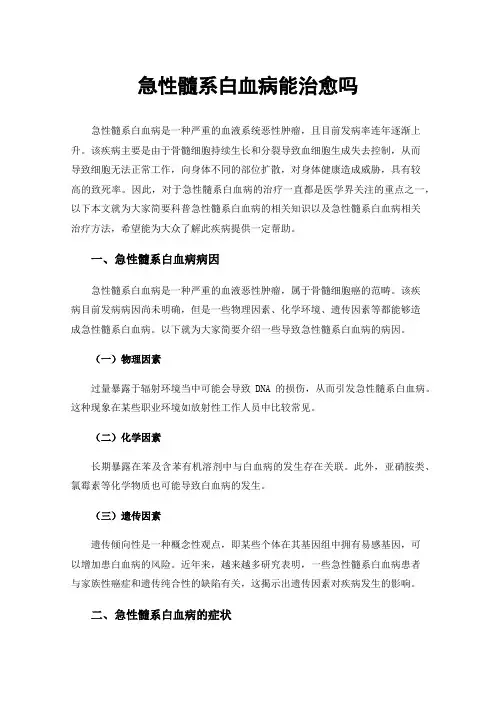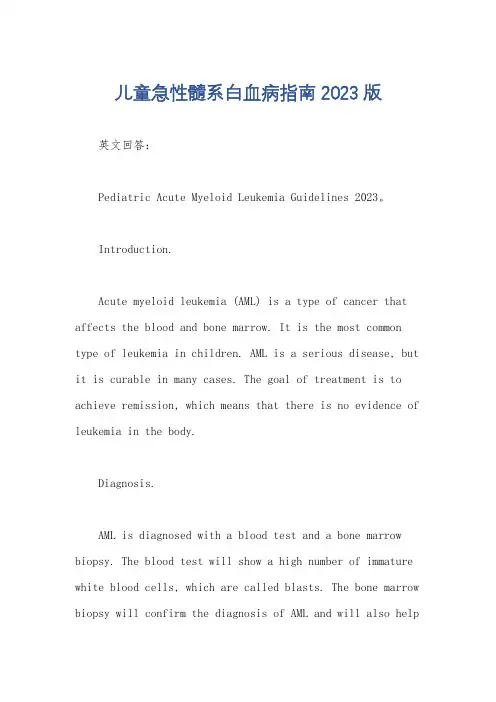《急性髓系白血病》
- 格式:ppt
- 大小:375.50 KB
- 文档页数:25

《成人急性髓系白血病诊疗规范(2018年版)》要点一、概述白血病(leukemia)是起源于造血干细胞的恶性克隆性疾病,受累细胞(白血病细胞)出现增殖失控、分化障碍、凋亡受阻,大量蓄积于骨髓和其他造血组织,从而抑制骨髓正常造血功能并浸润淋巴结、肝、脾等组织器官。
白血病的临床表现主要表现两类,一类是正常造血抑制导致的骨髓衰竭相关的临床表现,如贫血、白细胞减少导致的感染。
另一类是白血病细胞浸润组织器官引起的临床表现,如肝脾肿大、绿色瘤等。
白血病的诊断主要是依赖骨髓涂片计数原始细胞比例。
白血病的分型早期主要是依赖细胞形态学和细胞化学染色,目前白血病的分型主要是以流式细胞仪为基础的免疫学。
遗传学信息主要用于白血病患者的诊断分型和预后判断。
根据白血病细胞的分化程度和自然病程,将白血病分为急性和慢性两大类。
急性白血病(AL)细胞的分化停滞于早期阶段,多为原始细胞和早期幼稚细胞,病情发展迅速,自然病程仅数月。
慢性白血病(CL)细胞的分化停滞于晚期阶段,多为较成熟细胞或成熟细胞,病情相对缓慢,自然病程可达数年。
根据主要受累的细胞系列可将急性白血病分为急性淋巴细胞白血病(ALL)和急性髓系白血病(AML)。
慢性白血病则分为慢性髓性白血病,常称为慢性粒细胞白血病(CML)、慢性淋巴细胞白血病(CLL)及少见类型的白血病。
目前按照WHO造血系统和淋巴组织肿瘤分类,CLL与小淋巴细胞淋巴瘤为一类疾病,所以CLL的诊疗规范归入淋巴瘤部分。
临床上白血病的分类主要有两大标准,一个是FAB标准,临床重要性逐渐下降,见表1。
另一诊断分型标准是较新的WHO标准,见表2和表3。
二、急性髓系白血病(一)临床表现正常造血功能受抑制表现1. 贫血少数患者因病程短可无贫血,多数患者就诊时已有贫血。
2. 发热白血病本身可以发热,但发热往往提示有继发感染。
3. 出血主要为皮肤和黏膜出血,也可见消化道、呼吸道、泌尿道、眼底甚至中枢神经系统出血,严重时威胁生命。





急性髓系白血病能治愈吗急性髓系白血病是一种严重的血液系统恶性肿瘤,且目前发病率连年逐渐上升。
该疾病主要是由于骨髓细胞持续生长和分裂导致血细胞生成失去控制,从而导致细胞无法正常工作,向身体不同的部位扩散,对身体健康造成威胁,具有较高的致死率。
因此,对于急性髓系白血病的治疗一直都是医学界关注的重点之一,以下本文就为大家简要科普急性髓系白血病的相关知识以及急性髓系白血病相关治疗方法,希望能为大众了解此疾病提供一定帮助。
一、急性髓系白血病病因急性髓系白血病是一种严重的血液恶性肿瘤,属于骨髓细胞癌的范畴。
该疾病目前发病病因尚未明确,但是一些物理因素、化学环境、遗传因素等都能够造成急性髓系白血病。
以下就为大家简要介绍一些导致急性髓系白血病的病因。
(一)物理因素过量暴露于辐射环境当中可能会导致DNA的损伤,从而引发急性髓系白血病。
这种现象在某些职业环境如放射性工作人员中比较常见。
(二)化学因素长期暴露在苯及含苯有机溶剂中与白血病的发生存在关联。
此外,亚硝胺类、氯霉素等化学物质也可能导致白血病的发生。
(三)遗传因素遗传倾向性是一种概念性观点,即某些个体在其基因组中拥有易感基因,可以增加患白血病的风险。
近年来,越来越多研究表明,一些急性髓系白血病患者与家族性癌症和遗传纯合性的缺陷有关,这揭示出遗传因素对疾病发生的影响。
二、急性髓系白血病的症状在日常生活中患者或者是患者家属可以通过一些症状来判断是否患上急性髓系白血病,患者如果出现了相关的症状,需要及时到医院进行治疗,以免病情恶化,以下就为大家简要科普急性髓系白血病的症状。
(一)疲劳和虚弱急性髓系白血病患者会感到非常疲惫和虚弱,这是因为身体里的血液无法运输氧气和营养物质。
(二)感染白血病干细胞的生长也会导致正常的白细胞、红细胞和血小板数量下降,这使患者更容易受到感染。
(三)长期的呼吸道感染当患者患有淋巴细胞增多症时,他们更容易患上长期的呼吸道感染。
(四)出血和淤血由于血小板数量减少,急性髓系白血病患者会面临内出血、皮下出血和其他频繁出血的风险。




儿童急性髓系白血病指南2023版英文回答:Pediatric Acute Myeloid Leukemia Guidelines 2023。
Introduction.Acute myeloid leukemia (AML) is a type of cancer that affects the blood and bone marrow. It is the most common type of leukemia in children. AML is a serious disease, but it is curable in many cases. The goal of treatment is to achieve remission, which means that there is no evidence of leukemia in the body.Diagnosis.AML is diagnosed with a blood test and a bone marrow biopsy. The blood test will show a high number of immature white blood cells, which are called blasts. The bone marrow biopsy will confirm the diagnosis of AML and will also helpto determine the subtype of AML.Treatment.The treatment of AML is based on the subtype of AML and the child's age and overall health. The most common treatment for AML is chemotherapy. Chemotherapy is a type of medication that kills cancer cells. Other treatments for AML may include radiation therapy, stem cell transplant, and targeted therapy.Prognosis.The prognosis for AML depends on the subtype of AML, the child's age and overall health, and the response to treatment. The overall survival rate for children with AML is about 70%.Guidelines.The Children's Oncology Group (COG) has developed guidelines for the treatment of AML in children. Theguidelines are based on the latest research and evidence-based practices. The guidelines are updated regularly as new information becomes available.The 2023 COG AML Guidelines.The 2023 COG AML Guidelines are a comprehensive set of recommendations for the treatment of AML in children. The guidelines cover all aspects of AML care, from diagnosis to treatment to follow-up. The guidelines are designed to help healthcare providers provide the best possible care for children with AML.The key changes in the 2023 COG AML Guidelines include:New recommendations for the diagnosis andclassification of AML.New recommendations for the treatment of newly diagnosed AML.New recommendations for the treatment of relapsed AML.New recommendations for the supportive care of children with AML.The 2023 COG AML Guidelines are an important resource for healthcare providers who care for children with AML. The guidelines provide evidence-based recommendations for the diagnosis, treatment, and supportive care of children with AML.中文回答:儿童急性髓系白血病指南 2023 年版。
